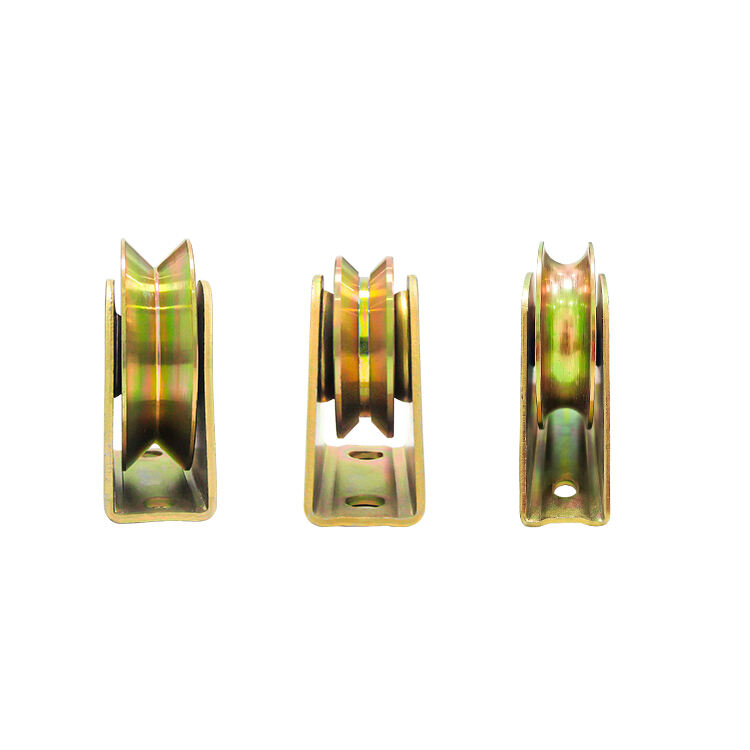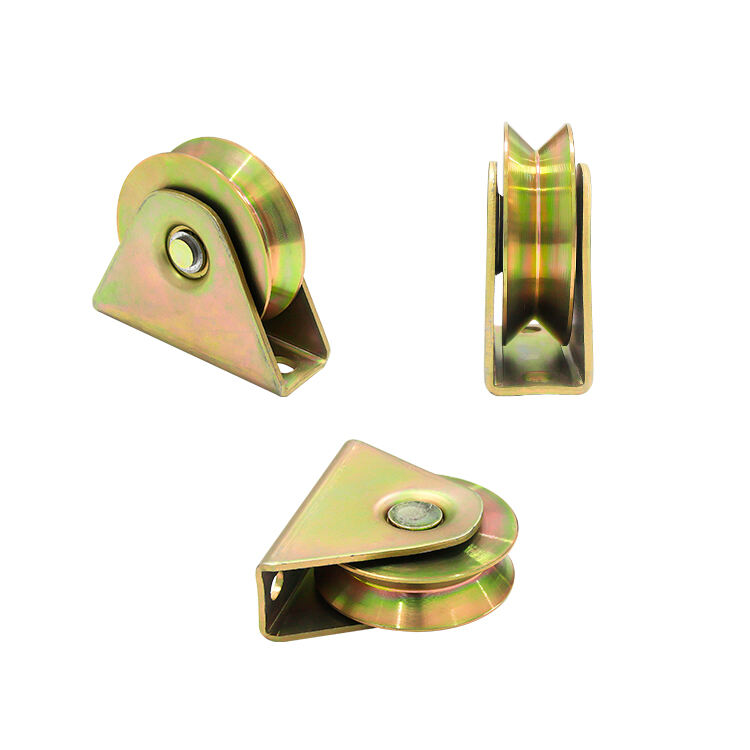घर्षण र हल्ला कम संग सुचारु संचालन सुनिश्चित
ढोका रोलर व्हीलले कसरी स्लाइडिंग गेटको चाल बढाउँछ
उच्च गुणस्तरको गेट रोलरले आधारभूत स्टील डिजाइनको तुलनामा ४०% सम्म घर्षण कम गर्नको लागि पोलीमर कम्पोजिट र फोर्ज्ड मिश्र धातु जस्ता सटीक ईन्जिनियरि and र उन्नत सामग्रीहरू प्रयोग गर्दछ (२०२३ सामग्री विज्ञान रिपोर्ट) । यसले १,५०० पाउण्डभन्दा बढी तौलका ढोकाहरूलाई सहज रूपमा सार्न सक्षम बनाउँछ, मोटर र हार्डवेयरलाई तनाव दिने झुक्याउने आन्दोलनलाई हटाउँछ।
लोड वितरण र समिकरण स्थिरताको पछाडि ईन्जिनियरिङ्
सुदृढ भार प्लेट र डबल-गोला-रेस असरले गेट रोलरहरूलाई समर्थन संरचनामा समान रूपमा वजन वितरण गर्न अनुमति दिन्छ। आत्म-सङ्क्रमण प्रणालीहरू स्वचालित रूपमा ±3° द्वारा समायोजन गर्न को लागी जमीन को निपटान को क्षतिपूर्ति गर्न, गलत समायोजन को कम गर्न। २०२४ गेट हार्डवेयर रिपोर्ट अनुसार, उचित पign्क्तिबद्धले उच्च ट्राफिक अनुप्रयोगहरूमा मर्मत आवृत्ति 62२% ले घटाउँछ।
उच्च गुणस्तरको रोलर प्रयोग गरी शहरी गेट प्रणालीहरूमा हल्ला घटाउने प्रवृत्ति
शहरी क्षेत्रहरूमा प्रायः आवासीय क्षेत्रहरूको नजिक 75 डीबी भन्दा कम सञ्चालन गर्न स्वचालित गेटहरू आवश्यक पर्दछ। कम्पन-डिम्पिंग आस्तीनको साथ नायलॉन-कोर रोलरहरूले परम्परागत धातु मोडेलहरू (२०२23 गेट प्रणाली शोर घटाउने अध्ययन) भन्दा %०% कम आवाज उत्पन्न गर्दछ, प्रभावकारी रूपमा 4,000,००० पाउन्ड भन्दा बढी भारलाई समर्थन गर्दा ग्राइन्डिंग आवाजको बारेमा गुनासोहरूलाई कम गर्दछ।
उच्च गुणस्तरको सामग्रीद्वारा अधिकतम स्थायित्व
जस्ती इस्पात बनाम स्टेनलेस इस्पात बनाम नायलॉन-लेपित गेट रोलर्सः एक स्थायित्व तुलना
रोलरको प्रयोगको समय र कामको मात्रामा फरक पार्ने कुरा जस्ती इस्पातमा जस्ताको तह हुन्छ जसले जंगलाई रोक्छ, त्यसैले यो तटबाट टाढाका घरहरूमा राम्रोसँग काम गर्छ। स्टेनलेस स्टीलको लागत ३० देखि ४० प्रतिशत बढी हुन्छ तर यसले जंगको सामना गर्न राम्रोसँग काम गर्छ, विशेष गरी खारा पानीको क्षेत्रमा वा कारखानाहरूमा जहाँ चीजहरू धेरै कठोर हुन्छन्। त्यसपछि त्यहाँ नायलॉन लेपित विकल्पहरू छन् जसले नियमित धातुको तुलनामा घर्षणमा लगभग 70% घटाउँछ, र तिनीहरूले बिच्छेद बिना रासायनिकहरू ह्यान्डल गर्छन्। यी प्रकारका शहर भवन र व्यवसाय मा धेरै देखा पर्न गर्छन किनभने तिनीहरू बस नियमित प्रयोग अन्तर्गत राम्रो राख्नुहुन्छ।
| सामग्री | औसत जीवनकाल | उत्तम प्रयोग मामला | राखरखाव अन्तराल |
|---|---|---|---|
| गैल्वेनाइज्ड स्टील | १०१५ वर्ष | आन्तरिक आवासीय गेटहरू | वार्षिक स्नेहन |
| स्टेनलेस स्टील | 25–30 वर्ष | तटीय/औद्योगिक प्रतिष्ठानहरू | दुई वर्षपछि निरीक्षण |
| नायलॉन लेपित | १२१८ वर्ष | शहरी/व्यावसायिक सम्पत्ति | त्रैमासिक सफाई |
विभिन्न जलवायुमा क्षरण प्रतिरोध र दीर्घकालीन प्रदर्शन
सन् २०२३ देखि एएसटीएम इन्टरनेसनलका अनुसार, सबै रोलर विफलताहरूको लगभग तीन चौथाई आर्द्रता परिवर्तन र तापमान उतार चढावको कारण हुन्छ। स्टेनलेस स्टीलले क्रोमियममा धनी सुरक्षा ओक्साइड तहको कारण भिजेको वातावरणमा राम्रोसँग टिक्छ। यसको बारेमा राम्रो कुरा यो छ कि यो तह वास्तवमा आफैँ ठीक हुन्छ यदि यो समयको साथमा खरोंच वा पहिरन हुन्छ भने। जहाँ हावामा धेरै नमी वा नुन छैन, त्यहाँ जस्ती इस्पातले प्रायः काम गर्छ। जब हामी कहिलेकाहीँ ती खराब अम्लीय वर्षाहरूसँग सामना गर्छौं (केही पनि pH 5.6 भन्दा कम वास्तवमा), नायलॉन कोटिंगले ठूलो भिन्नता बनाउँछ। तिनीहरूले समस्याहरू रोक्छन् र इलेक्ट्रोलाइटिक क्षरणसँग लड्छन् जबकि धातुका भागहरू एक अर्कालाई सिधै छुन आवश्यक बिना लगभग सात देखि दस वर्षसम्म चीजहरू सहज रूपमा चल्दछन्।
लागत बनाम दीर्घायुः के प्रीमियम गेट रोलरहरू लगानीको लायक छन्?
नायलॉन लेपित रोलरहरू स्टेनलेस स्टीलको विकल्पहरू भन्दा ३५ देखि ४० प्रतिशत सस्तो देखिन्छ, तर यी बचतहरूको मूल्य हुन्छ। व्यस्त परिचालनमा जहाँ उपकरणहरू निरन्तर प्रयोग गरिन्छ, नायलॉन संस्करणहरू लगभग दुई र आधा गुणा बढी बारम्बार प्रतिस्थापन गर्न आवश्यक छ। हालैको अनुसन्धान अनुसार NIST ले आफ्नो 2024 रिपोर्टमा सामग्री जीवनचक्रमा स्टेनलेस स्टीलको लागत 58% कम हुन्छ जब बीस वर्षमा खर्चको तुलनामा जस्ती स्टीलको तुलनामा हेर्छ। स्वचालित मेसिनरी सेटअपको सन्दर्भमा, राम्रो गुणस्तरको रोलरले पनि वास्तविक भिन्नता ल्याउँछ। अपग्रेडले मोटर तनाव कम गर्न मद्दत गर्छ र गत वर्षको DOE दक्षता मापदण्ड अनुसार ऊर्जा बिलमा १५ देखि २२ प्रतिशतसम्म बचत गर्दछ। रोलरको अवस्थालाई नियाल्ने र पूर्ण रूपमा बिग्रनुअघि त्यसलाई प्रतिस्थापन गर्ने सुविधा प्रबन्धकहरूले केवल मर्मत खर्चमा मात्र हरेक वर्ष १२०० देखि ५००० डलरसम्म बचत गर्न सक्छन्।
गेट सुरक्षा र संरचनात्मक स्थिरता सुधार
कसरी गाइड रोलरहरूले तनावको अवस्थामा सुरक्षा बढाउँछन् र डेरेलमेन्टबाट जोगाउँछन्
उच्च गुणस्तरका गेट रोलरहरू धेरै भार ढोएको अवस्थामा पनि रेलहरूलाई संरेखित राख्छन्, जसले सम्भावित डेरेलमेन्टबाट बचाउको रूपमा महत्वपूर्ण सुरक्षा प्रदान गर्दछ। औद्योगिक शक्तिका मोडेलहरूले लगभग २५०० पाउण्डसम्मको ऊर्ध्वाधर भार सहन गर्न सक्छन् र बलियो हावा वा मानिसहरूले जबरजस्ती प्रवेश गर्न खोज्दा उत्पन्न हुने पार्श्व दबाबलाई पनि झेल्न सक्छन्। टेपर्ड रोलर बेयरिङ्गसँग ल्याएका गाइड व्हीलहरूले सामान्य बुशिङ्गहरूको तुलनामा पार्श्व गतिलाई लगभग ९०% सम्म कम गर्दछ, जसको अर्थ अचानक रोकिने अवस्थामा पनि ट्र्याकहरू जमिनको सतहसँग निरन्तर सम्पर्कमा रहन्छ। यो विशेष गरी ती क्षेत्रहरूका लागि धेरै महत्त्वपूर्ण छ जहाँ सुरक्षा प्रमुख प्राथमिकता हुन्छ, जस्तै डाटा सेन्टर र प्रमुख लोजिस्टिक्स सुविधाहरू, जुन गत वर्षको पेरिमिटर सिक्युरिटी रिपोर्टमा प्रकाशित निष्कर्षहरूले देखाएको छ।
ठूला, उच्च-यातायात भएका स्थापनाहरूलाई समर्थन गर्नमा भारी गेट रोलरहरूको भूमिका
दोहोरो सील गरिएका बेयरिङ्गसँग ढालेर बनेका स्टील कोर रोलरहरू व्यावसायिक स्थानहरूमा धेरै राम्रोसँग काम गर्छन् जहाँ प्रत्येक दिन ३०० भन्दा बढी साइकलहरू सँगठित गर्नुपर्छ। तीस फिट भन्दा बढी चौडा ढोकाहरूका लागि यी रोलरहरूले एक्सल झुकावलाई लगभग ४० प्रतिशत सम्म घटाउँछन्, जसले संरचनाहरूमा घिस्रण सुरु हुनुको एक प्रमुख कारणलाई सम्बोधन गर्छ। नगरपालिका भवनहरू, जस्तै अपशिष्ट जल उपचार केन्द्रहरूले आफ्ना उच्च गुणस्तरका रोलरहरूले लगभग सात वर्षसम्म चल्ने पाएका छन्, जबकि सस्ता विकल्पहरूले प्रतिस्थापन गर्नुअघि लगभग अठार महिनामात्र चल्ने पाइएको छ। यो धेरै महत्त्वपूर्ण छ किनभने अनपेक्षित रोकथामले कडा नियमन पालन गर्नुपर्ने स्थानहरूमा प्रति घण्टा १,२०० डलरभन्दा बढीको नोक्सानी हुन सक्छ।
उत्तम ढोका स्थिरताका लागि वजन वितरण र संरेखण
रोलरको दूरी १/१६ इन्च भित्र राख्नुले प्रणालीमा तौल कसरी वितरण हुन्छ भन्ने कुरामा फरक पार्छ। उदाहरणका लागि मानक ४० फिट स्टील गेट लिनुहोस्, धेरै जसो स्थापनाहरूले चीजहरू ढाक्नबाट जोगाउन प्रत्येक आठ फिटमा राखिएको तीन चरण रोलरहरू प्रयोग गर्दछ। जब हामी परम्परागत हातका औजारको सट्टा लेजर निर्देशित सेटअपमा स्विच गर्छौं, हामी लगभग ६५ प्रतिशत कम पहिरन र फाड समस्या देख्छौं विशेष गरी ती नमकीन तटीय क्षेत्रमा जहाँ जंग सधैं चिन्ताको विषय हुन्छ। नयाँ स्वचालित प्रणालीहरूमा यी स्मार्ट लोड सेन्सरहरू छन् जसले परिस्थिति परिवर्तन भएपछि रोलरको दबावलाई समायोजन गर्दछ। गत वर्ष गरिएको परीक्षण अनुसार यी समायोजनहरूले मोटरलाई पहिलेको तुलनामा २२ प्रतिशत लामो समयसम्म चलाउन मद्दत गर्छ। तर, अचम्मको कुरा के छ भने, तिनीहरू अत्यन्तै कडा सहिष्णुता कायम राख्छन्, भूकम्प वा अचानक प्रभावको नजिकै हुँदा पनि।
मोटरको जीवन लम्ब्याउनुहोस् र मर्मतसम्भारको खर्च घटाउनुहोस्
गुणस्तरीय गेट रोलरले स्वचालित गेट मोटर्समा कसरी तनाव कम गर्छ
सटीक ईन्जिनियरिङ् गेट रोलरले मोटर्समा घर्षण र मेकानिकल तनावलाई कम गर्दछ, 40% सम्मको पोषण घटाउँछ (ईन्जिनियरिङ् रिपोर्ट 2023) । उचित पङ्क्तिबद्धताले निरन्तर शक्ति स्थानान्तरण सुनिश्चित गर्दछ, मोटर गिरावट र विद्युतीय सर्जलाई तीव्र बनाउने झटका हटाउँछ।
मर्मत र प्रतिस्थापनको कम आवृत्तिद्वारा दीर्घकालीन बचत
प्रिमियम रोलर प्रयोग गर्ने सुविधाहरूले वार्षिक २२% कम मोटर मर्मतको अनुभव गर्दछन्, लगभग $१२०० प्रति गेट प्रणाली बचत गर्दछ। मुख्य लाभहरू निम्न समावेश गर्दछः
- रोलरहरू जफत भएको कारण आपतकालीन मोटर प्रतिस्थापनबाट बच्न
- रोलरसँग सम्बन्धित विद्युतीय गल्तीहरूको निदानको लागि कम श्रम
- गियरबक्सको पुनर्निर्माणको रोकथाम कम्पन असंतुलनको कारण
सक्रिय मर्मतसम्भार: प्रणाली विफलता अघि पहेंलो रोलरहरू प्रतिस्थापन
अधिकांश निर्माताहरूले हरेक ६ महिनामा जाँच गर्ने सुझाव दिन्छन् किनकि ती साना रोलर विकृतिहरू जुन हामी नाङ्गो आँखाले पनि देख्न सक्दैनौं वास्तवमा मोटर्सलाई बढी काम गर्न लगाउँछ, कहिलेकाँही तिनीहरूको लोड १५ देखि ३० प्रतिशतसम्म बढाउँछ। ३५० भन्दा धेरै स्वचालित गेट प्रणालीहरूमा संकलन गरिएका तापक्रमका तस्बिरहरू हेर्दा यो स्पष्ट हुन्छ कि जब रोलरहरू ढल्किन थाल्छन्, मोटरको तापक्रम करिब १८ डिग्री फारेनहाइट वा १० डिग्री सेल्सियससम्म बढ्छ। यो केवल मोटरहरूको लागि न्यानो मौसम मात्र होइन यद्यपि यो एक महत्वपूर्ण बिन्दुमा पुग्छ जहाँ इन्सुलेशन घुमावहरूमा बिग्रन थाल्छ। गत वर्ष फेसिलिटी म्यानेजमेन्ट जर्नलका अनुसार नियमित रूपमा प्रतिस्थापन गर्ने प्लान्टमा मोटरको जीवनकाल तीन गुणा बढी हुन्छ। र हामी यो कुरालाई स्वीकार गरौं, समस्याहरू हुनुअघि मर्मतसम्भारमा पैसा खर्च गर्दा व्यवसायीहरूले लगभग तीन डलर बचत गर्छन् हरेक डलरमा जुन उनीहरूले केही बिग्रिएपछि चीजहरू मर्मत गर्न खर्च गर्छन्।
आवासीय, व्यावसायिक, र औद्योगिक ढोकाहरूमा आदर्श अनुप्रयोगहरू
घरको प्रयोग: सौन्दर्य, चुपचाप काम गर्ने र काम गर्ने तरिका
आवासीय गेट रोलरहरूले मौन प्रदर्शन (≤२2024 उद्योग परीक्षणहरूमा dB२2035 dB) र दृश्य एकीकरणलाई प्राथमिकता दिन्छ। पोलीयुरेथेन लेपित रोलरहरूले धातु संस्करणहरूको तुलनामा 62% ले रातको आवाज घटाउँछ (2023 गेट प्रणाली विश्लेषण), आधुनिक वास्तुशिल्प शैलीहरूको पूरक हुँदा 1,200 पाउन्ड सम्म समर्थन गर्दछ।
व्यापारिक ढोकाहरू: स्थायित्व र बारम्बार प्रयोगको माग
व्यावसायिक स्थापनाहरूले ५०,०००+ चक्रहरूको लागि रेटेड रोलरहरू माग गर्दछ। ३०४ ग्रेड स्टेनलेस स्टील अब नयाँ शहरी परियोजनाहरूको ६५% मा निर्दिष्ट गरिएको छ (२०२४ औद्योगिक सामग्री रिपोर्ट) । तातो-गठबन्धित नायलॉन रोलर्स 40% ले खारा वातावरणमा जस्ती इस्पात भन्दा लामो समयसम्म रहन्छ, तिनीहरूलाई तटीय व्यापार पार्क र रसद केन्द्रहरूको लागि आदर्श बनाउँछ।
औद्योगिक अनुप्रयोगहरूः अत्यधिक भार र कठोर वातावरण ह्यान्डल गर्दै
१५,००० पाउण्डभन्दा बढी तौलका भारी ड्युटी रोलरहरू बहुअक्षीय पिभोट असरहरूसहित सुसज्जित हुन्छन् जसले गलत समिकरणका समस्याहरू राम्रोसँग सम्हाल्छन्। तिनीहरूसँग ग्राफाइटले भरिएको सील बुशिंग पनि छ जसले लगभग ८० प्रतिशतले लुब्रिकेशन आवश्यकतालाई कम गर्दछ। साथै यी घटकहरू ASTM B117 मापदण्डहरू पूरा गर्ने सामग्रीहरूसँग लेपित छन् र नुन स्प्रे परीक्षणहरूमा 5,000 घण्टा भन्दा बढीको सामना गर्न सक्छन्। यसको वास्तविक प्रयोगको अर्थ के हो? यी अपग्रेडहरू चरम वातावरणमा राम्रोसँग काम गर्दछन् जस्तै माइनस ४० डिग्री फारेनहाइटमा सञ्चालन हुने शीत भण्डारण सुविधाहरू वा रासायनिक प्रशोधन संयन्त्र भित्र। गत वर्षको सर्वेक्षणबाट प्राप्त हालैका उद्योगका तथ्याङ्कहरू अनुसार, लगभग ९० प्रतिशत प्लान्ट म्यानेजरहरूले यी उन्नत रोलर समाधानहरू लागू गरेपछि कम ब्रेकडाउन र कम समय खर्च गर्ने प्रणालीहरू देखे।
FAQ खण्ड
गेट रोलर व्हील किन महत्त्वपूर्ण छ?
गेट रोलर व्हीलहरू महत्त्वपूर्ण छन् किनकि तिनीहरूले चिल्लो स्लाइडिंग गेट आन्दोलन बढाउँछन्, घर्षण र आवाज कम गर्छन्, र पर्याप्त भारहरू समर्थन गर्छन्, तिनीहरूलाई विभिन्न अनुप्रयोगहरूको लागि आदर्श बनाउँदछन्।
गेट रोलरका लागि सामान्यतया कुन सामग्री प्रयोग गरिन्छ?
गेट रोलरहरूको लागि प्रयोग हुने सामान्य सामग्रीहरूमा जस्ती इस्पात, स्टेनलेस स्टील, र नायलॉन समावेश छ, प्रत्येकको स्थायित्व, संक्षारण प्रतिरोध, र विभिन्न वातावरणमा प्रदर्शनको हिसाबले यसको अद्वितीय फाइदाहरू छन्।
गेट रोलरले गेट सुरक्षालाई कसरी असर गर्छ?
उच्च गुणस्तरको गेट रोलरले तनावको अवस्थामा पनि रेलहरू समतल रहन सुनिश्चित गर्दछ, रेलबाट बाहिर निस्कन रोक्छ र डाटा सेन्टर र रसद हब जस्ता सुविधाहरूमा सुरक्षा सुनिश्चित गर्दछ।




